Everything in Kathmandu has a story to tell. Even the buffaloes.
The Kathmandu Valley has always been fertile. Here, wave after a wave of human migration has arrived to escape famine or war, in search of plenty, and blended into whatever culture existed at the time. Some of the oldest inscriptions found on the statues of deities tell equally of strife and conquest and social and religious acceptance and intermingling. Even the founding myth of Kathmandu is the story of an immigrant arriving at a new land and settling: Aeons ago, Manjushree, the Bodhisattva, came to pay homage to the sacred light emanating from a lake. He cut through the hills with his sword to the south of what is now the site of Swayambhunath—one of the most sacred Buddhist sites—draining the water from the valley and establishing its first civilization.
How rich Kathmandu must have appeared to a newly arrived settler looking in from one of the mountain passes! Fish and fowl would have been abundant in the natural ponds in the landscape that was once a giant lake. Any seed thrown to the ground would have taken root, flowered, and borne fruit. The climate would have been pleasant, never severe, no signs of dust and pollution, and the sights of the snow-capped Himalayas to the north would stop any new settler in their tracks. Although the cultural prehistory of the valley is lost to us, it is possible to imagine the story through its food.
Sinki and Gundruk: The buried goods
Kathmandu was prosperous because of its rich agricultural land and the inter-civilizational trade connecting the gold and silk of China to the spices and corals of India. The land was so fertile that the inhabitants, out of deference to Pashupatinath, the patron deity of the valley, used no draft animal for tillage, and still produced enough grain to barter for salt with Tibet.
This prosperity attracted periodical raids by aggressors from the west and the south—most frequently, the invaders were the Khas from the Sinja Valley in Jumla, hundreds of miles to the west. These raiders would burn down the city, scatter the city-folks into the surrounding mountains, and loot the riches from temples and monasteries before retreating.
Lore has it that during one such raid, the farmers of the valley buried their harvest of radishes and the boiled, sliced shoot of bamboo just a few days old, along with other foods to deny their invaders sustenance. When they dug out the buried foods after a few months, the radishes and leaves had fermented into a fragrant, sour pickle. That’s how the fermented radish sinki and radish leaves gundruk, beloved of Nepalis, is said to have been born. Both are versatile, excellent either as a tart and piquant chutney preparation or as the fragrant and sour note in a broth accompanying hot rice. Seek out Amako at one of the farmers’ markets for an excellent selection of fermented pickles—radish, watermelon rind, hog-plum, and much more.
Dhindo: The mountain fuel
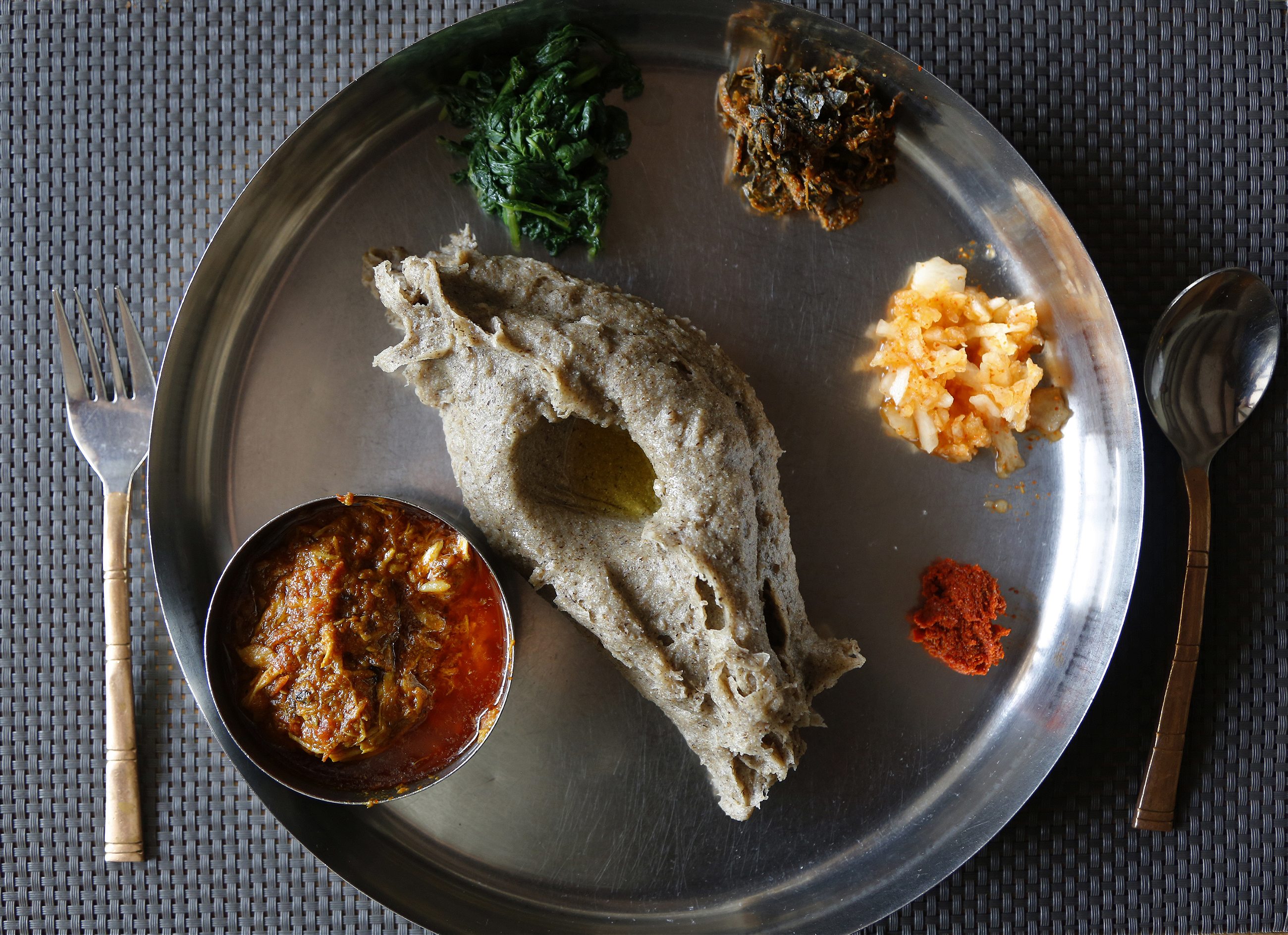
What are called hills in Nepal can reach nearly a vertical mile higher than their valley floors, and it it’s not unusual for a day’s walk to involve climbing over three or four hills. Millet is the proto-grain of the Nepali mountains—the thick, dark gruel of ground millet, called dhindo, fuels the many uphill and downhill climb necessary through a day’s hard work for Nepalis living in the mid-hills and the taller mountains. More so than rice, wheat, buckwheat or maize, millet has fed the people of Nepal. Cooked into a thick gruel in which the wooden spatula used to beat it can stand upright, it sits snug in the belly, and fuels the difficult climbs over the mountains.
Once associated with the poorest of the poor, and now elevated to delicacy status by the affluent urban class, dhindo was most often eaten with the hot broth of gundruk, and maybe a fresh green chili to add bite. It is available in most places that serve the Thakali thali in Kathmandu. But to really enjoy proper dhindo these days in Kathmandu, one must find a “staff hotel” that serves bus drivers and their assistants. The preferred accompaniment is the curry of a free-range, local variety of rooster, spiced with cumin and coriander and simmered long enough for the marrows to flavor the broth.
Thon: Salutations to the gods

Thon, the watered-down fermented mash of cooked rice, is a home-brewed favorite of the Newars, Kathmandu’s original inhabitants. Traditionally offered as a salutation to the gods, thon flows uninterrupted from the mouth of the nearly 10-feet tall mask of Shweta Bhairav—the most fearsome incarnation of Lord Shiva—on the day of Indra Jatra, when the living goddess of Kathmandu is taken on her annual procession through the heart of the ancient city. Even today, thon is consumed during the numerous feasts observed by the Newars.
There are at least three varieties of thon worth discussing: the fresh, slightly effervescent thon, the thick and sour kar-thon, and the wine-red hyau-thon.
Thon is a thin, white brew with the color and consistency of rice-water, and the perfect indigenous beer to begin a Kathmandu adventure. Kar-thon is murkier in color, closer to porridge in texture and refreshingly tart. It is also a lot more potent, suddenly setting atilt the ground beneath one’s feet. Hyau-thon is more of a cultural experience than it is a casual drink. Rice is steamed in a bundle of red muslin without letting it cook through entirely. A hollow is shaped into the mound of rice. No yeast or starting culture is added. Yeast in the air starts the fermentation. Then, painfully slowly, a russet liquor pools into the hollow. It is collected in a separate vessel a few spoonful at a time every day and considered a tonic and restorative. Show gratitude, sip, don’t quaff. Newa Lahana in Kirtipur is an ideal venue for your thon experience.
[Read: A love letter to Raksi, Nepal’s sweet fiery homebrew]
Buffalo meat: A boon from the goddess
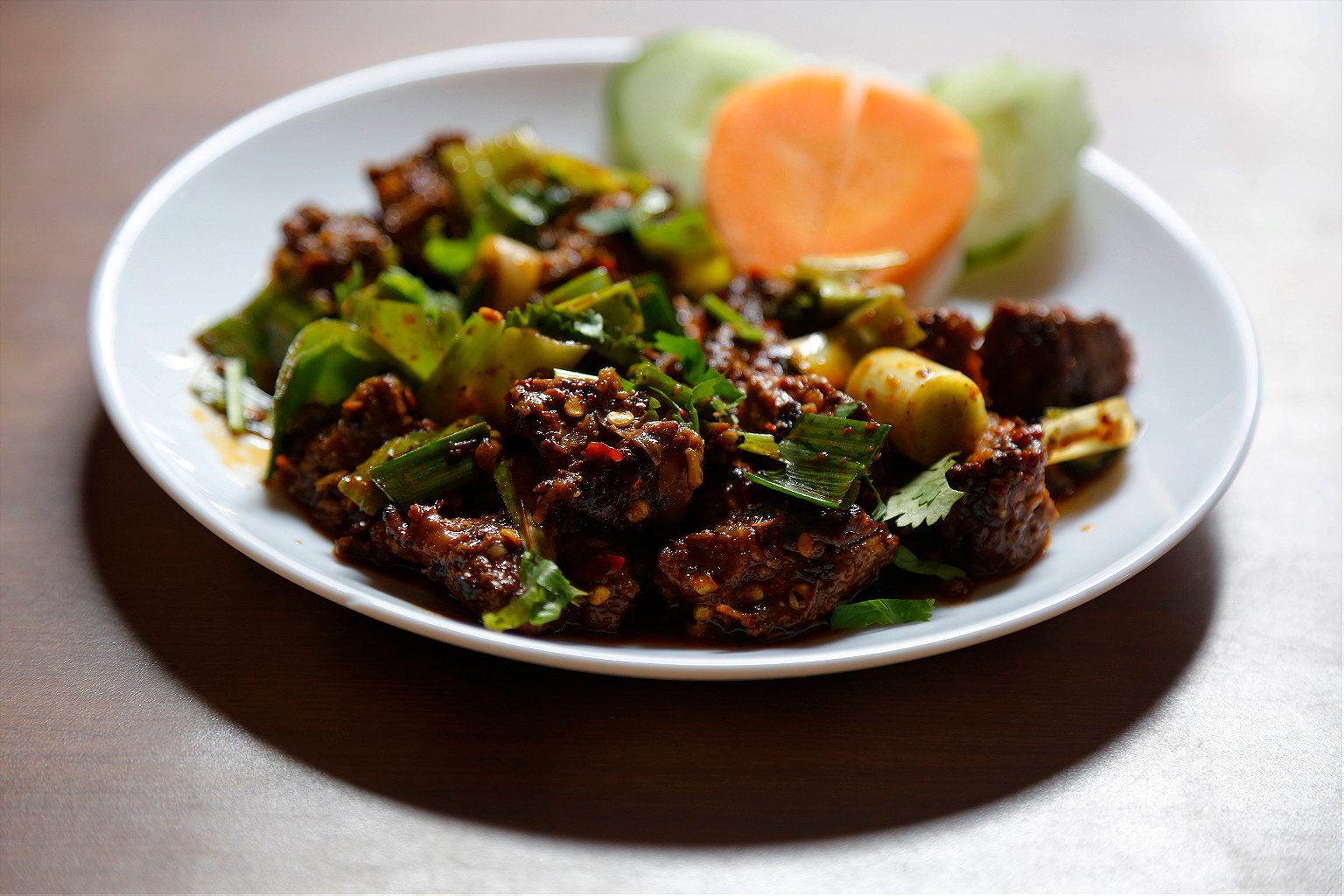
Centuries ago, the water buffalo was introduced to the inhabitants of Kathmandu as ritual food: sacrificed to gods and goddesses, it became the celebrated and sacred meat for the Newars. From the fried cord of the spine to the mince that goes into the ever-popular momo, when it comes to meat in Nepal, buffalo is king.
The neighborhood of Chyasal in Patan is home to clans devoted to the perfection of the Newari cuisine—and they have been busy doing just that, now boasting that they make over 200 different preparations of buffalo meat. The grilled sekuwa and marinated-after-broiling chhwela are perhaps the most widely recognized iterations of the buffalo on the plate, but there is a lot more on offer at the right place: the finely ground mincemeat locally known as kachila; fried brain or slices of the tongue; lesser cuts simmered in spices until tender known as dyakula; the takha and sun nakhuna jellies; syapu mihcha, the hot, explosive pocket of marrow deep-fried in intestine; testes boiled and sliced; blood sausages, and so on. For an excellent menu of buffalo-based dishes, head to Kwacha in Patan and ask for whatever is on display over the counter that day.
Momo(cha): A trading in treats
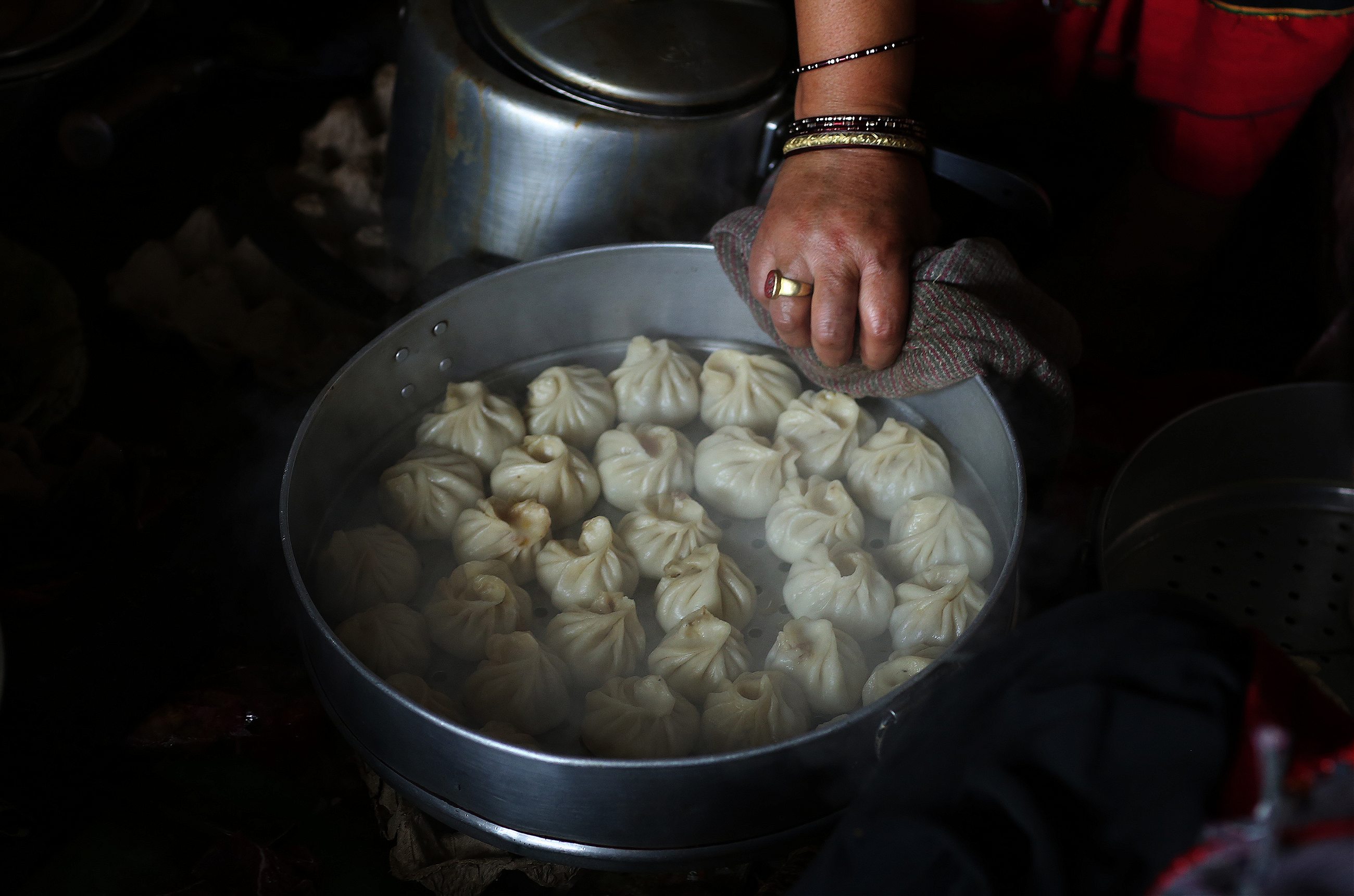
When Kathmandu’s Newar traders went to Lhasa, in Tibet, they encountered meat dumplings made with yak-meat filling. When the traders returned to Nepal, they carried with them the know-how of the dish and transformed them into the diminutive momocha, aromatic with the spices native to Nepal. When tomato and chili pepper arrived in Kathmandu, the accompanying spicy jhol achar—a tangy chutney with the consistency of a sauce—elevated the momocha. Today, momos may be the most popular snack in Nepal, but they are no momocha.
The best momocha is still made at home, amid banter with family and friends. Or they are found in the narrowest alleys in the oldest parts of the three cities in the Kathmandu Valley. A good momocha bursts open in the mouth and fills the nostrils with sharp, floral, warm, and earthy spices.
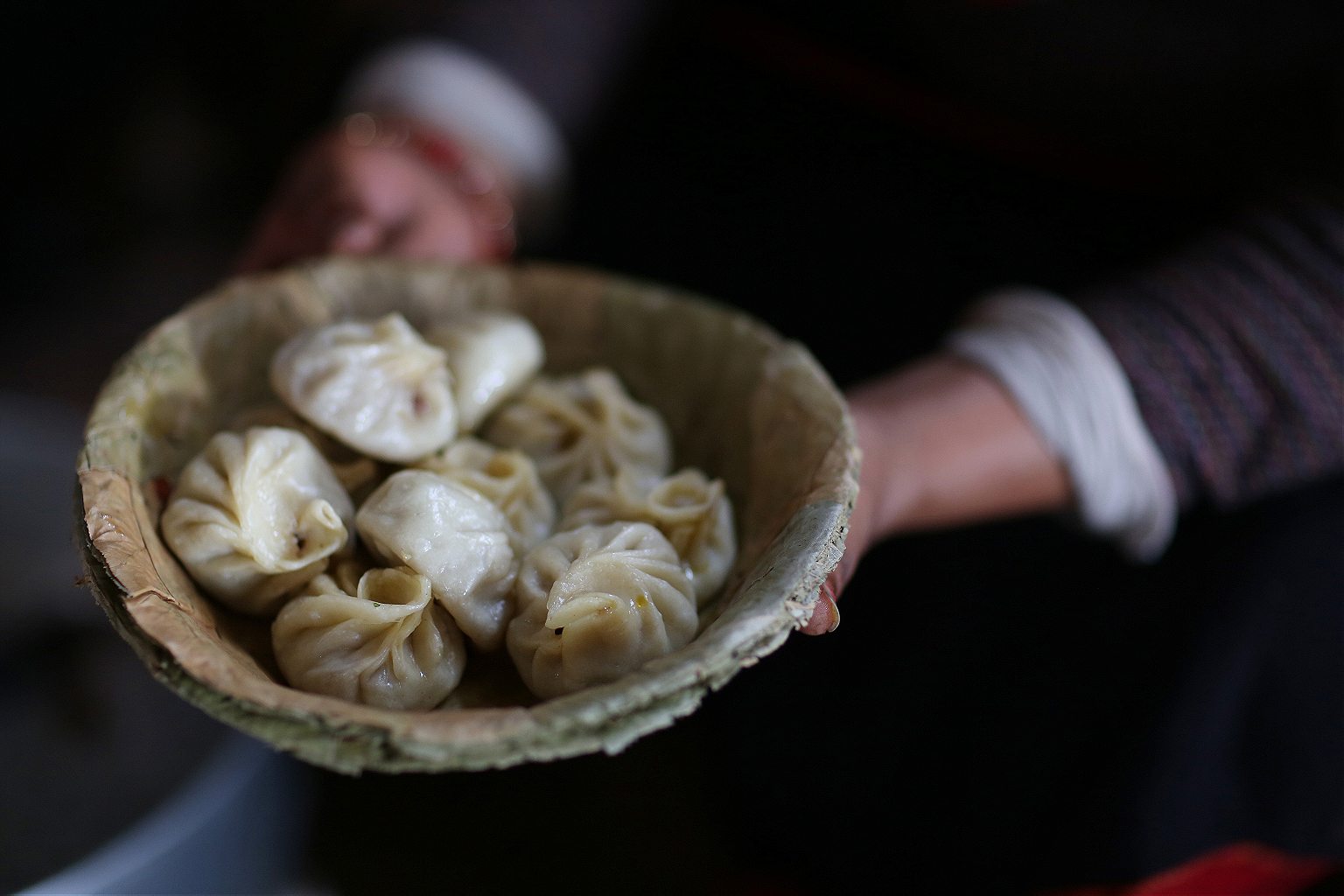
There is a reason this is the most popular snack across the country, and why it is nothing like any of the other meat dumplings from around the region: the Newari cook is a master of the spices their families have been trading for thousands of years. The spice basis for the heat in the momocha can differ from one household to another. Depending on the season and the weather outside, the cook can adjust the spices and leanness of the fillings to warm the body or fill the belly or, simply, provide the base for a day of bonding.
[Read: Momos are the best dumplings in the world]
Chhwela: The working class treat
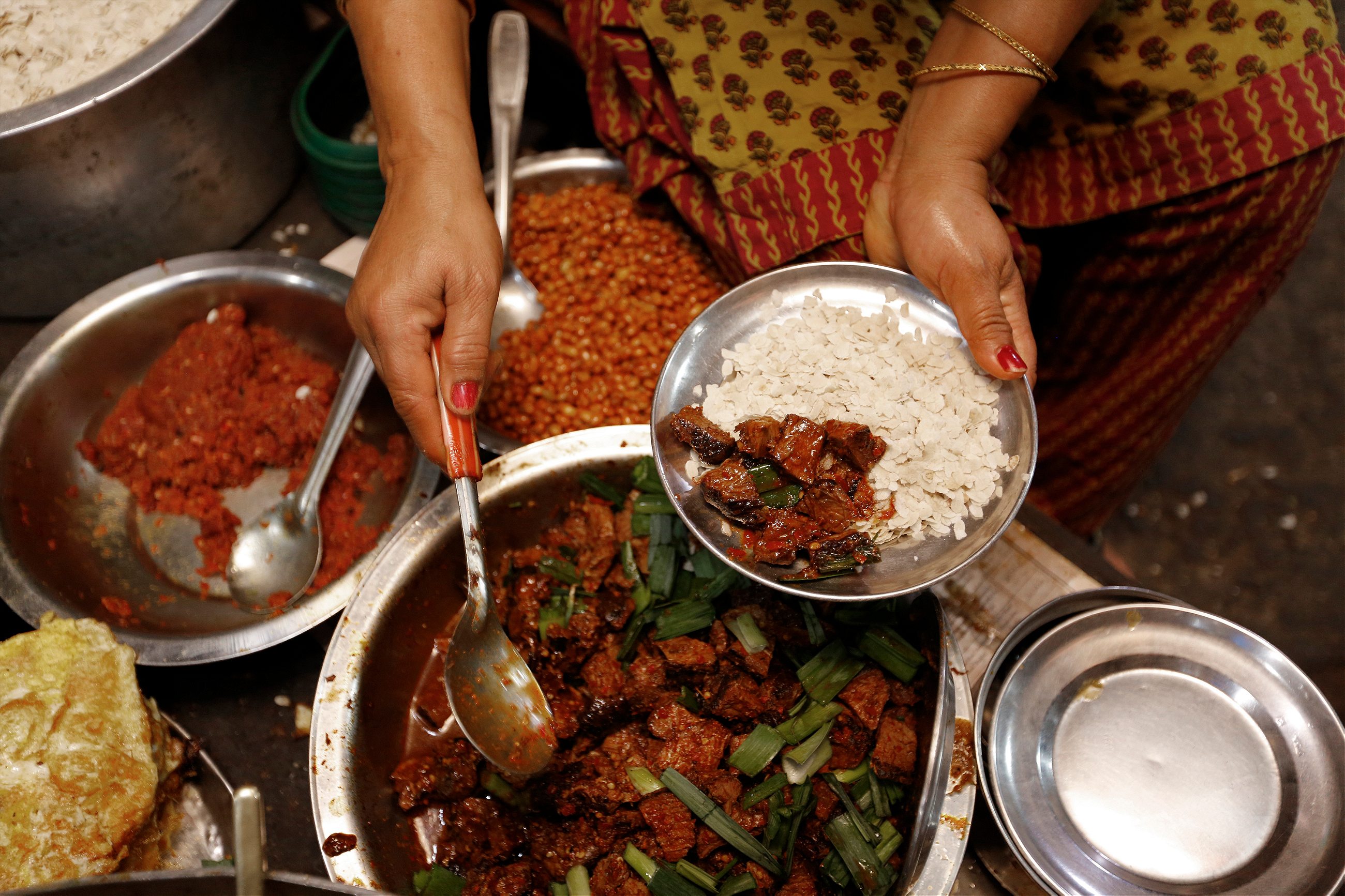
Cuts of red meat, traditionally from buffalo or goat, blackened in the smoke of damp straws, cubed and tempered with mustard oil and hot spices, chhwela is the most popular accompaniment to the mid-day snack of beaten rice. Some people consider the dish incomplete without slivers of ginger, garlic, and green onions, while others prefer them unadorned, but tender. Each chhwela joint takes pride in serving their own unique version.
No one really knows how chhwela became the popular dish it is today, but some locals believe it was invented by oil-pressers after a long day of pressing mustard oil by hand. The story goes that the workers lit a fire of mustard straw and broiled a large hunk of meat over it, then cut the broiled meat into strips, tenderizing them by passing them through the oil press that was still pungent with freshly pressed mustard oil. Others say the workers may have also done that to “pollute” the oil press by defiling it with meat, so nobody outside their caste—who alone had the traditional right to earn money from this trade—could use the machine.
Because it pairs so well with the local liquor, chhwela is available in most local restaurants. But the best chhwela is still the kind served at family and clan feasts. Some preparations lean towards the basic: chili and oil paste, slivers of garlic and ginger, half-inch lengths of garlic and onion greens. Other preparations may be more elaborate, with a tempering paste of tomatoes lending the flesh sweetness, and the aroma and flavor coming from spices sautéed in mustard oil before being poured over the partially broiled meat. Head to Harisiddhi Newa Suhlee for their signature haku chhwela.
[Read: How to spend a perfect day exploring and eating in Patan]
Mari: Spice-filled sweetness
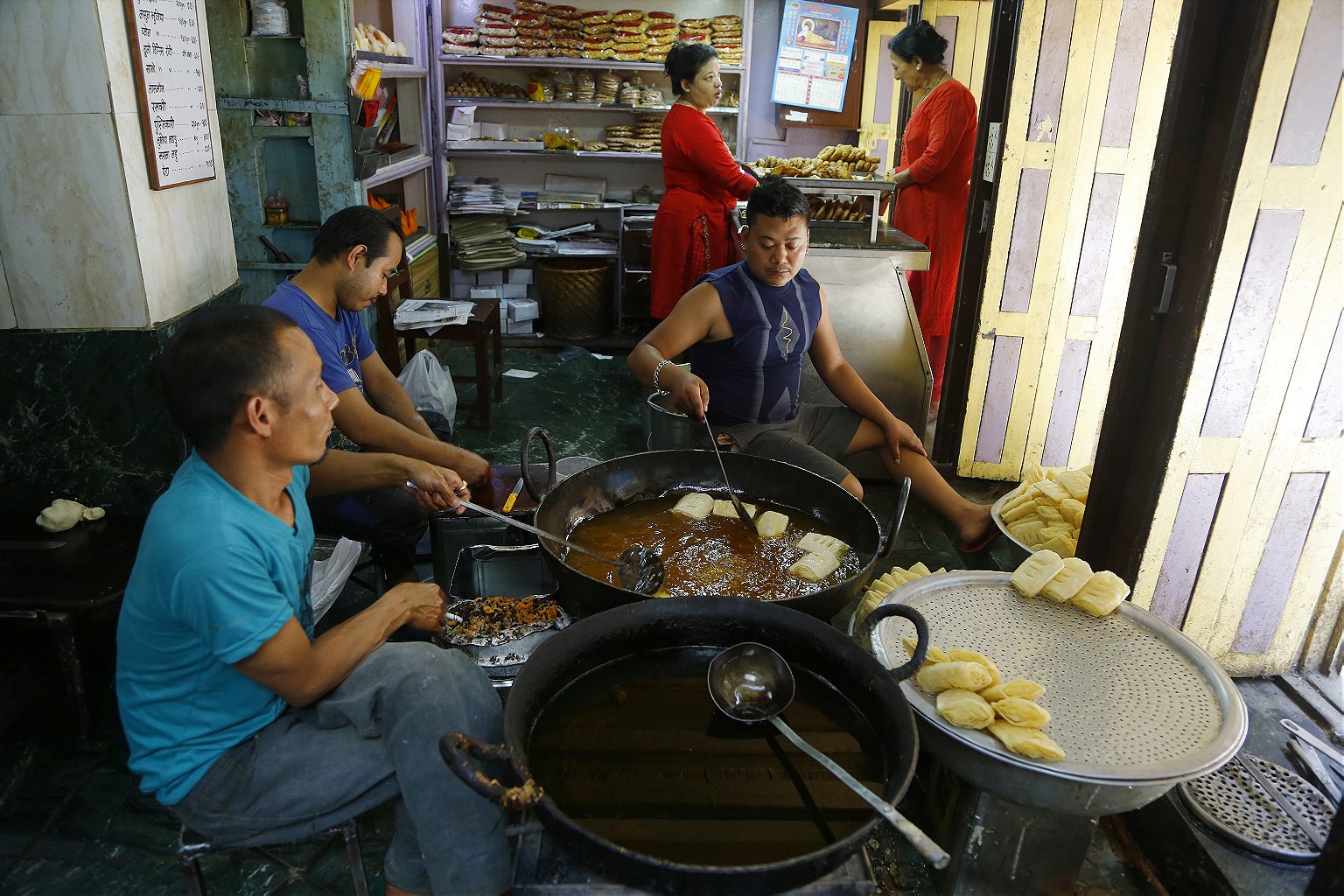
The Newars are a diverse group: there are strict vegetarians among both the Hindu and Buddhist groups. Some are clans devoted to the art of the sweetmeat. The many mari, or fried sweets and breads, also incorporate spices brought from South India—the coconut, cardamom, and clove—and have a faint resemblance to the sweetmeats of North India. Newar sweetmeats are typically saturated with sugar, and are brittle or flaky. The brittle, sugar-encrusted maris are especially suited to being carried over long distances and preserved over long periods.
The Tichhu alley in Patan, running parallel to the south of the road along Patan Durbar Square, is fragrant and frenzied in the mornings. Here, borderline diabetics wait for their breakfast of warm jeri (fried, sugary sweet) and ghee-drenched puri and swari (soft, deep-fried breads), recalling the Newars’ long relationship with cities like Kolkata and Benaras in India.
Juju Dhau: Fit for the kings
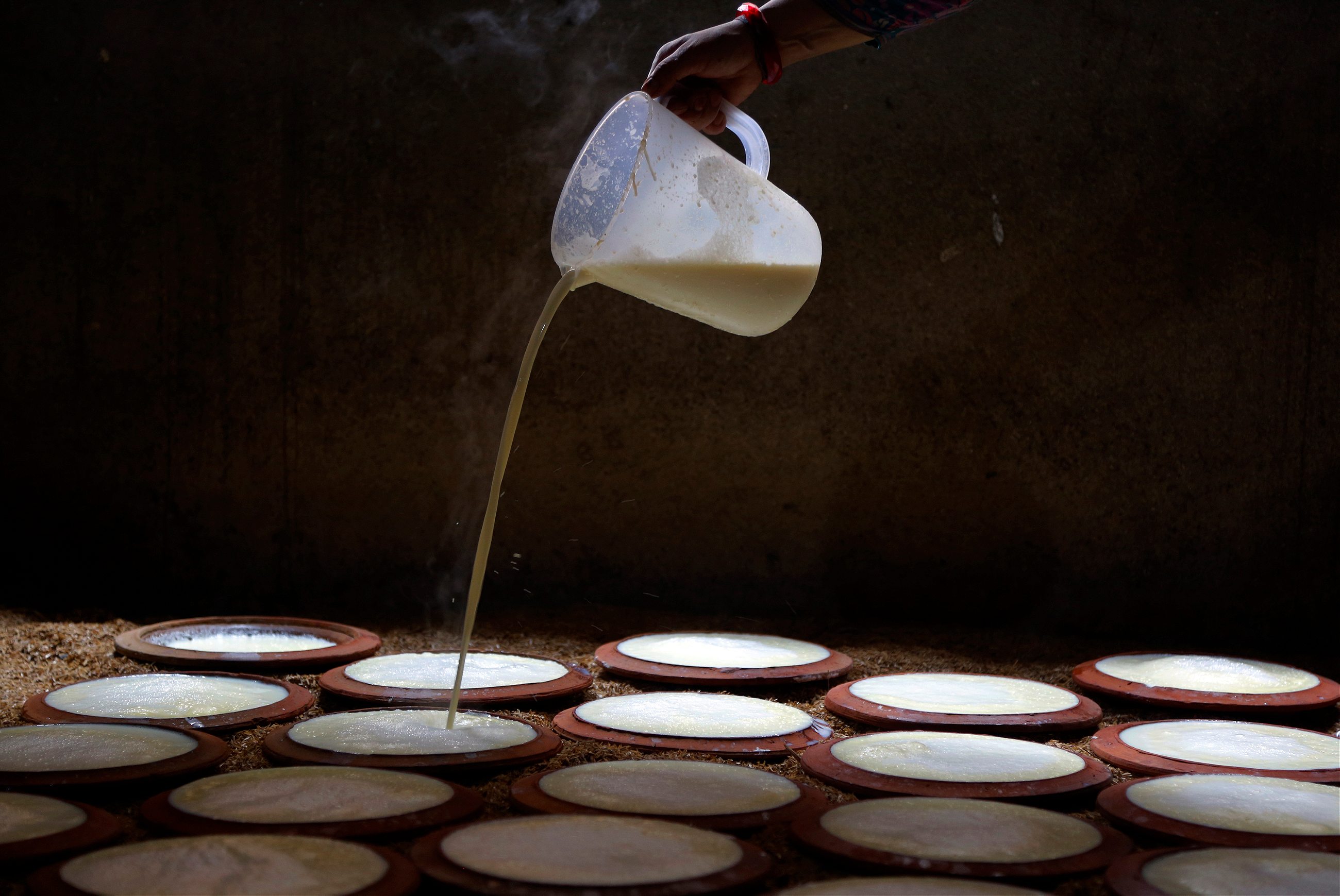
Quite literally named Yogurt for the King, or, alternately, the king of yogurts, the Bhaktapur style of Juju dhau is dense and rich with a depth of sweetness not found in anything else.
Making a yogurt requires precision and vigilance. Begin with a baked, clean earthen pot; pour into it milk that has been reduced by stirring it over a low flame for hours; add a bit of culture; wait; when the pot has absorbed the water in the whey and thickened and reduced the yoghurt further, bury the pot up to its neck in a pile of rice-grain husks to control the rate at which the milk cools; add more milk—perhaps as many as four times overnight—to compensate for the continuous reduction and thickening of the milk in the pot, etc.
The result is a rich, silky, clotted and sweet yogurt—truly fit for a king.
Chatamari & Bara: People’s food
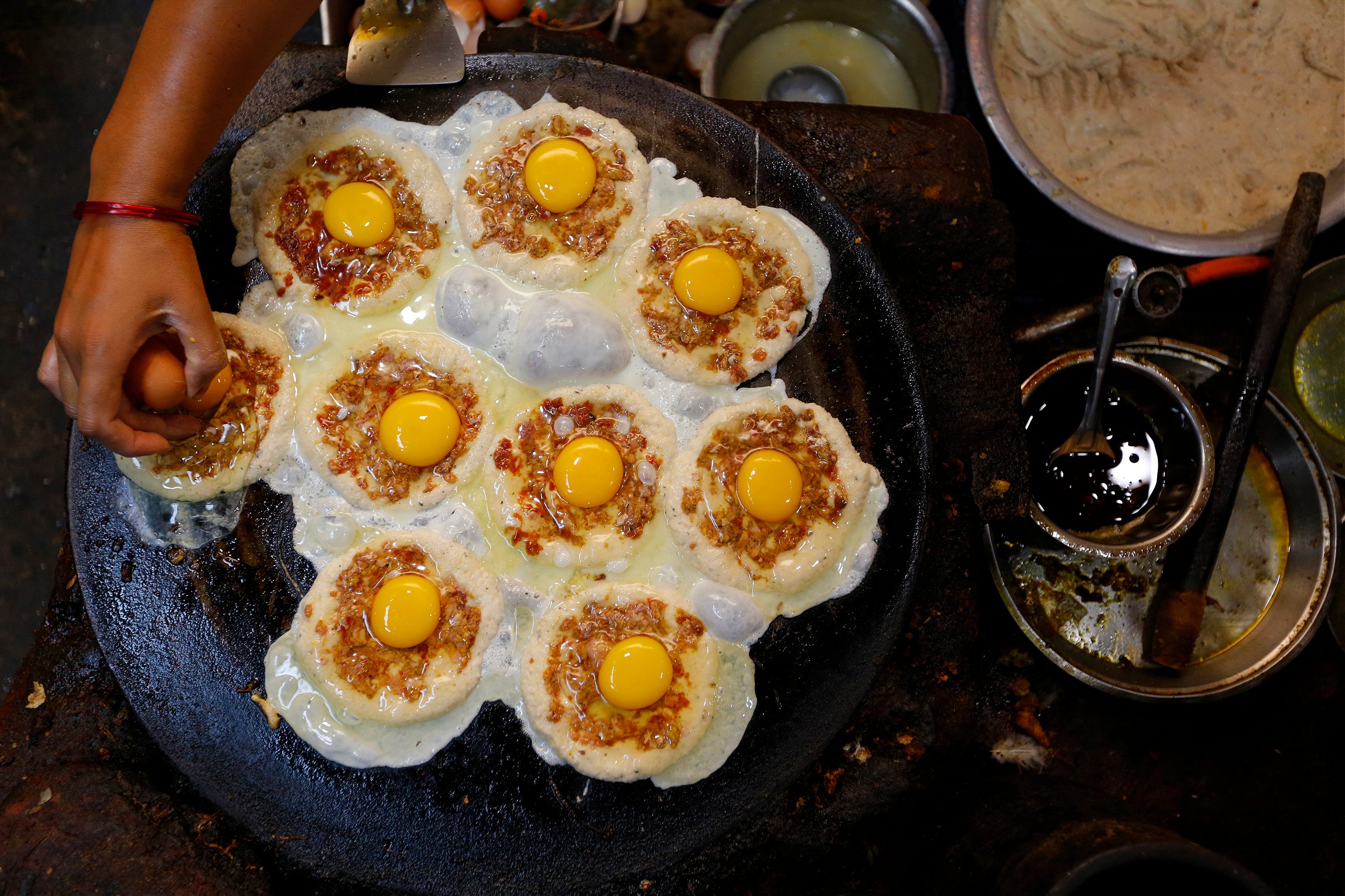
The three large city-states of Kathmandu—Kathmandu, Bhaktapur, Lalitpur—and the many satellite settlements of Tokha, Kirtipur, Bungamati, Panauti, Banepa, Harisiddhi, etc., have been urban settlements for nearly 2,000 years. Like in most cities and towns, people ate out in neighborhood joints that served stews, meats, and breads.
The most popular of such snack-breads are chatamari and woh, also sometimes misidentified as bara. Chatamari has found purchase with the tourists as ‘Newari pizza’—a thin rice-flour pancake variously topped with mincemeat, egg, tomatoes, etc. Woh maybe had as the pan-baked bread of a variety of lentils, with or without mincemeat and egg toppings.
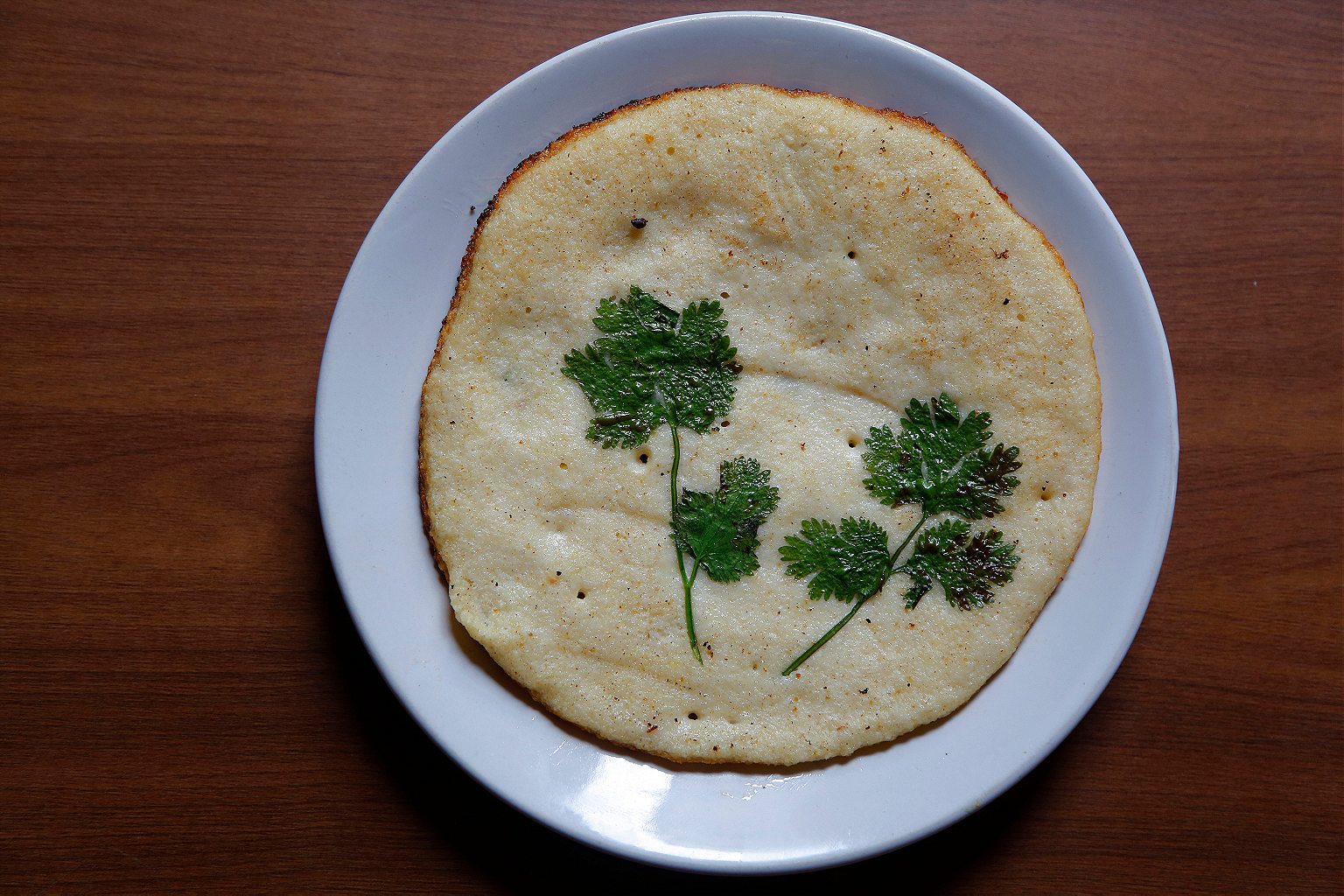
Directly behind the iconic Krishna temple in the Patan Durbar Square is Honacha, itself an institution over a century old. The cook may have over a dozen wohs going on a large cast iron skillet–some the plain, unadorned variety, some with an egg broken over it, and yet others with a layer of spiced mincemeat with an egg over it. Ask for dyakla broth to be poured over your woh for additional flavor.
Jimbu: The aroma of Nepal
A herb that grows wild on the slopes of the Himalaya, jimbu is most familiar to Nepalis across the world as the funky grass burned in a tempering of hot ghee or oil which is then dunked into black lentil or black beans dal.
But it may also appear in other dishes, the most interesting of which is the potato and goat-jerky curry tempered with jimbu, a Thakali specialty. Jimbu is the aroma that binds the people of Kathmandu and Nepal together. Definitely ask for the potato and goat-jerky curry tempered with jimbu if you find yourself at Thakkhola Thakali Cuisine on the restaurant lane of Jhamsikhel, in Patan.
Thukpa & Laphing: Arrival of Tibetans

The oldest mention of Nepal—the original name for the Valley—is in connection with woolen blankets and yak tails that came from Tibet. The people of Kathmandu used salt brought from Tibet, while the coinage for Tibet was minted in Kathmandu. Then in 1959, following the invasion of Lhasa by the Chinese army, thousands of Tibetans were forced to flee their homes. Nepal became the natural refuge.
When Tibetan refugees came and started settlements across Nepal, they came bearing the seeds of the industries that would boost the country’s economy: tourism, carpets, a culture of eating out. Momo and noodles became the most popular dishes consumed outside the home. A trekker in the mountains of Nepal will likely eat all of their meals as inflected by the Tibetan touch: garlic soup for the altitude, the hot bowl of thukpa noodle soup, the fried rice—none of these existed in their present form before the settlement of Tibetans as refugees in Nepal.
More recently, laphing—the slippery, flat srips of mung bean noodles served with a tart and savory cold sauce—has taken the streets of Kathmandu by storm. There is a local iteration of it, featuring a filling of the ever popular Wai Wai pre-cooked noodles. Just as a generation had arrived at their experience of street food through palate-burning plates of momos, a new generation is discovering itself in the dark, piquant and tart laphing sauce. After a walk around the sacred stupa of Bouddhanath, make your way to Double Dorje for Tibetan fare cooked by a gruff but loving mother.